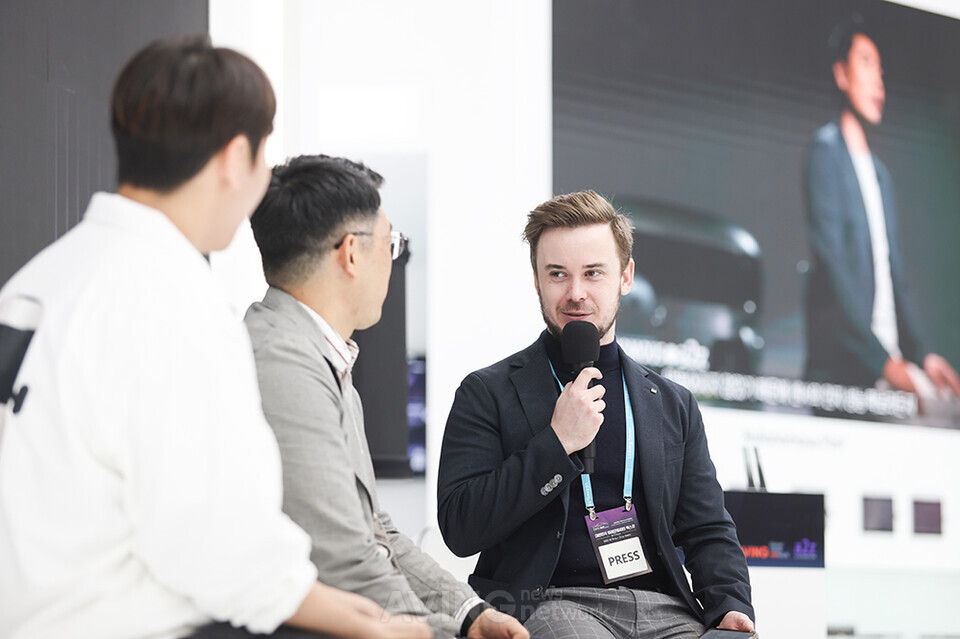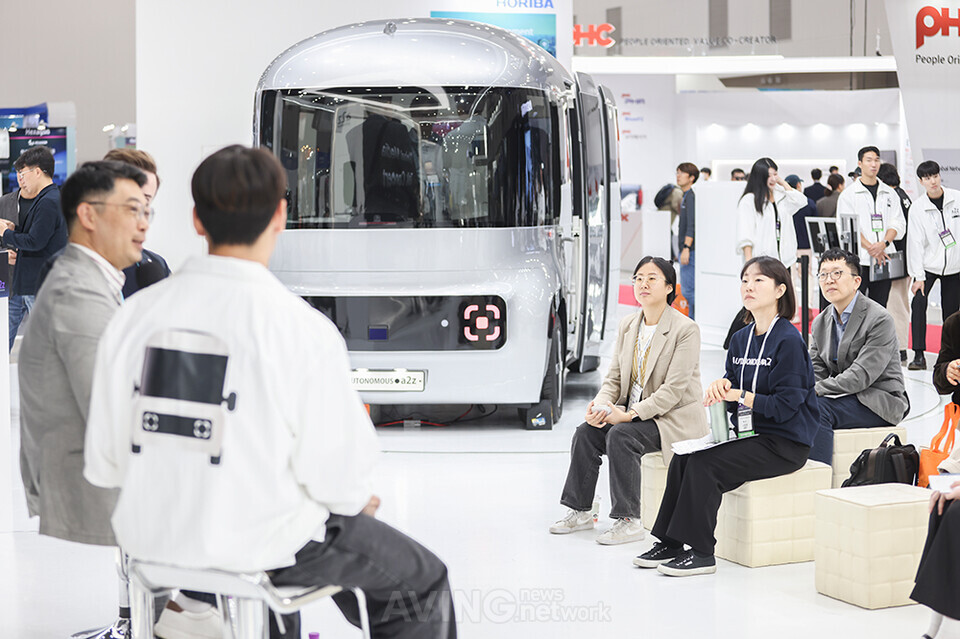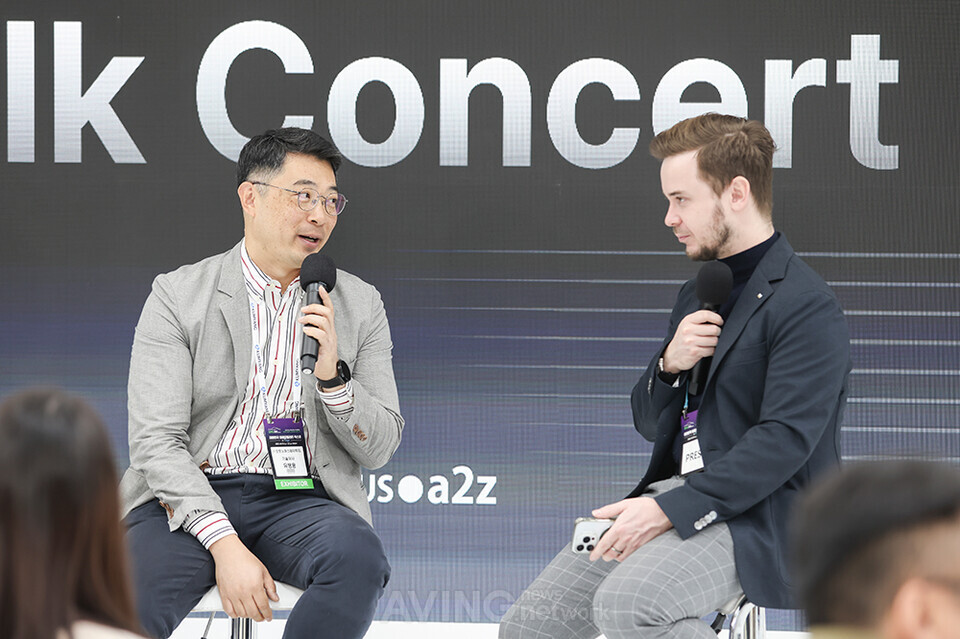Press Autonomous a2z Presents its “Level 4 Autonomous Driving Technology and Outlook” at the Global Media Talk Concert with a French Media Outlet
페이지 정보
작성자 Autonomous a2z 조회 192 작성일 2023-11-08본문
(From left to right) Chan-young Hwang, Manager of the Remote Driving System Development Team at Autonomous a2z, Byungyong You, Director of Technology at Autonomous a2z, and Leo Thevenet, editor-in-chief of Le Café du Geek during the Global Media Talk Concert hosted at the Autonomous a2z booth at the 2023 Daegu International Future Auto & Mobility Expo (DIFA) on Friday, October 20. | Photo by Aving News
-“We want to make Level 4 autonomous driving technology a reality!” - Byungyong You, Director of Technology
-Autonomous a2z aims to commercialize Level 4 shuttle buses (MS) by 2025 and fully autonomous vehicles by 2027
Autonomous a2z, an autonomous driving company specializing in the development of unmanned mobility platforms, invited Leo Thevenet, editor-in-chief of Le Café du Geek, a French IT and AI media outlet, to host the Global Media Talk Concert at the 2023 Daegu International Future Auto & Mobility Expo (DIFA) on Friday, October 20.
The topics of the talk concert included the functional aspects and commercialization of Autonomous a2z's Level 4 autonomous driving software, which enables the operation of Autonomous a2z's autonomous vehicles “MS” and “SD,” the role of Autonomous a2z in the Korean autonomous driving market, and the prospects for potential expansion into markets overseas. Byungyong You, Director of Technology at Autonomous a2z, answered Mr. Thevenet's questions in Korean, which Chan-young Hwang, Manager of the Remote Driving System Development Team at Autonomous a2z translated into French.
“It’s my first time at DIFA and I am astounded by the scale of the exhibition,” said editor-in-chief Leo Thevenet, who opened the talk with a question on how Autonomous a2z came to participate as an exhibitor at DIFA.
“We are very excited to showcase MS and SD to the public for the firs time,” said Byungyong You, Director of Technology at Autonomous a2z. “We've gotten a lot of compliments on their appearance,” he added. Many of the visitors who had the opportunity to ride in the two vehicles also inquired about various aspects, including the release date and prices of the vehicles, after receiving explanations about their functional features such as sensors. Director You commented, “While these questions may seem simple and direct, we believe that this interest in our products will serve as the foundation for our company's leadership in the Level 4 autonomous driving market.”
In South Korea, autonomous vehicles can be piloted on any roads except for child protection zones and elderly protection zones, as long as a license issued by the Ministry of Land, Infrastructure, and Transport (MOLIT) is obtained. However, this license is issued for research purposes only and is valid for five years. Actual services, including paid driving services, can only be conducted in autonomous driving pilot areas designated by MOLIT.
Using the situation in France as an example, Mr. Thevenet asked about the progress of autonomous driving technology development in Korea and piloting. “France became the first European country to begin piloting autonomous vehicles on public roads last December. However, we have not reached Level 4 technology, which allows for fully automated driving, so humans still have to control and monitor the operation using 5G communications,” he explained.
Director You commented, “Current Korean legislation doesn't pose a problem for the development of autonomous technology and vehicles. But regulations are still being developed as fully driverless vehicles have yet to be properly piloted. We expect to see guidelines that will enable commercialization around 2025.”
“To be honest, the reason why I believe Korea has yet to secure a leading position in the global autonomous driving market is partly because of technology, but also because of the restrictions imposed through legislation, and the same goes for Europe. Unlike the U.S., South Korea and Europe apply positive regulations, which makes us somewhat conservative and behind everyone else when it comes to technological innovation,” Director You elaborated.

(From right to left) Leo Thevenet, editor-in-chief of Le Café du Geek, asks a question to Byungyong You, Director of Technology at Autonomous a2z, during the Global Media Talk Concert on Friday, October 20. | Photo by Aving News
At this year’s DIFA, Autonomous a2z unveiled MS and SD, their “complete autonomous vehicles.” Surprisingly, however, it wasn’t the company’s initial intention to develop and manufacture autonomous vehicles. At first, the company planned to release software for Level 4 autonomous driving and apply the solutions to retrofitted vehicles. However, the vehicles that Autonomous a2z piloted over the past 4-5 years failed to exhibit the desired performance. As a result, the company began developing its own hardware capable of supporting the new software. That led to the development of the MS and SD models that were showcased at this year's DIFA.
When asked by editor-in-chief Thevenet if there were any collaborations with other companies in the process of developing autonomous vehicles, Director You mentioned, “Manufacturing MS and SD would have been impossible for a startup like ourselves to accomplish independently.” He further explained, “At that time, we had to source components from Korean companies initially due to our limited access to overseas suppliers. We were fortunate to have many competitive components manufacturers in Daegu, and it's thanks to them that the pilot models are seeing the light of day.”
Editor-in-chief Thevenet continued with his questions, asking when Level 4 autonomous driving software will be commercially available in South Korea, and where he expects to see the most active use of Autonomous a2z's models.
Director You answered, “At Autonomous a2z, we want to make Level 4 autonomous driving technology a reality. So our focus right now is to align development with the policies of the South Korean government. Our current goals are the commercialization of Level 4 shuttle buses (MS) by 2025 and the complete commercialization of full autonomous driving by 2027, which we have designated as our catchphrase. If everything proceeds as intended, we hope to see hundreds or even thousands of autonomous vehicles on the road by 2027.”
In his explanation, Director You re-emphasized that the company's business strategy is geared towards B2B and B2G, not B2C. He said he envisions autonomous driving being used with infrastructure vehicles, like town buses in urban areas.
“We aim for our autonomous vehicles to serve as a reliable mode of transportation, built on a secure platform comprising three essential components: radar, LiDAR, and cameras,” stated Director You. “And these are the elements that we consider indispensable for the Level 4 autonomous driving market of the future.”
After a series of questions, editor-in-chief Thevenet shifted the direction of his questions to the SD model. Mr. Thevenet asked, “The SD model has no windows because it was designed for cargo delivery. Do you think it will be feasible, in a few years, for the vehicle to be used for leisure purposes, such as watching a movie inside the windowless SD?” In other words, the editor-in-chief wanted to know if driving could be left to the technology, while all passengers inside the vehicle could fully enjoy their own activities, whether that involves remote work or watching a movie.
“First of all, SD is designed for cargo and MS for passengers, but the roles of the two vehicles may change,” said Director You. “In the era of full autonomous driving, there will be no need for windows. If you need a vehicle for one or two people, I suppose you could convert the SD into a personal vehicle. We're considering various adaptable designs,” he replied.

A view of the Global Media Talk Concert held at the 2023 Daegu International Future Auto & Mobility Expo (DIFA) on Friday, October 20. | Photo by Aving News
Mr. Thevenet then asked whether the new technology that is autonomous driving will be seamlessly integrated into everyday life. “As in other countries, Korean drivers have been driving manually for a long time and are very accustomed to it,” he said. “What do you believe will be the so-called ‘public acceptable’ threshold for autonomous driving technology?”
Director You responded, “Among the 10 cities where autonomous driving platforms are currently being run, Daegu and Sejong have the highest number of vehicles in operation. The citizens of these cities have become very familiar with autonomous vehicles, having utilized the service for the past 3 to 4 years. During this time, they have felt and experienced how autonomous vehicles can enrich their lives, so they are very receptive.”
Director You cited underserved transportation areas as an example of where autonomous vehicles should be introduced before anywhere else. With fewer residents, the transportation companies' deficits have increased in these areas, leading to a reduction in the number of buses and other public transportation routes. These companies also struggle to recruit drivers, which have virtually prevented the cities' transportation system from functioning normally. “There is a huge problem with transportation due to the lack of drivers, and quickly introducing autonomous vehicles in these cities could help revitalize the transportation ecosystem in these areas,” Director You explained.
“It is normal for people who are still accustomed to manual driving to be unfamiliar with the behaviors of autonomous driving vehicles, such as stopping and controlling the speed of the vehicle on their own,” Director You added. “We are hoping to take the technology up a notch by introducing HMI (human-machine interface) features, which will inform the driver about these behaviors so that the driver can relax and enjoy their time or utilize the space in the vehicle without having to worry about driving at all.”
Director You pointed out, “Other challenges include overcoming the ‘trolley dilemma,’ which can cause delays due to rapid changes in signals, and developing technology that complies with local cybersecurity laws and regulations when entering European countries.”
Finally, when asked by editor-in-chief Thevenet about the company’s outlook for 2024, Director You said that Autonomous a2z will continue to expand into overseas markets and prepare for an IPO. “We are currently in talks with various countries for piloting,” he said. “In addition, our Series B funding, which we completed last month, is still on track for the IPO listing we promised our investors for the second half of 2025. We will continue to concentrate our efforts in these two domains.”
In particular, Director You cited the case of Germany. He explained that Germany was the first country in the world to finalize regulations for Level 4 autonomous driving, and that in order to commercialize Level 4 autonomous vehicles in Germany, companies must prove that they have advanced remote technologies. In other words, if an autonomous vehicle encounters a problem while driving unmanned, the German government will want to see if the issue can be remotely resolved.

Byungyong You (left), Director of Technology at Autonomous a2z, answers questions from Leo Thevenet (right), editor-in-chief of Le Café du Geek, during the Global Media Talk Concert on Friday, October 20. | Photo by Aving News
Director You stated, “We consider remote technology to be the most crucial foundational technology necessary for entering the Level 4 autonomous driving market. We have developed this technology and are implementing it in our vehicles, which is why we are optimistic about entering the German market.”
Meanwhile, the 2023 DIFA, which has been held for the seventh time in Daegu since 2017, covered the entire mobility industry, including eco-friendly vehicles (electric and hydrogen), motorized parts such as motors, batteries, and chargers, autonomous driving, and urban air mobility (UAM) under the theme of From the ground to the sky, a new beginning of mobility. In particular, as the Ministry of Land, Infrastructure, and Transport and the Ministry of Trade, Industry, and Energy, the co-host Ministries, are the two main pillars of policy promotion in preparation for the era of full autonomous driving services and UAM commercialization through 2027-2030, the exhibition showcased the technological achievements supported by the policy focus and introduced the latest policy directions.


